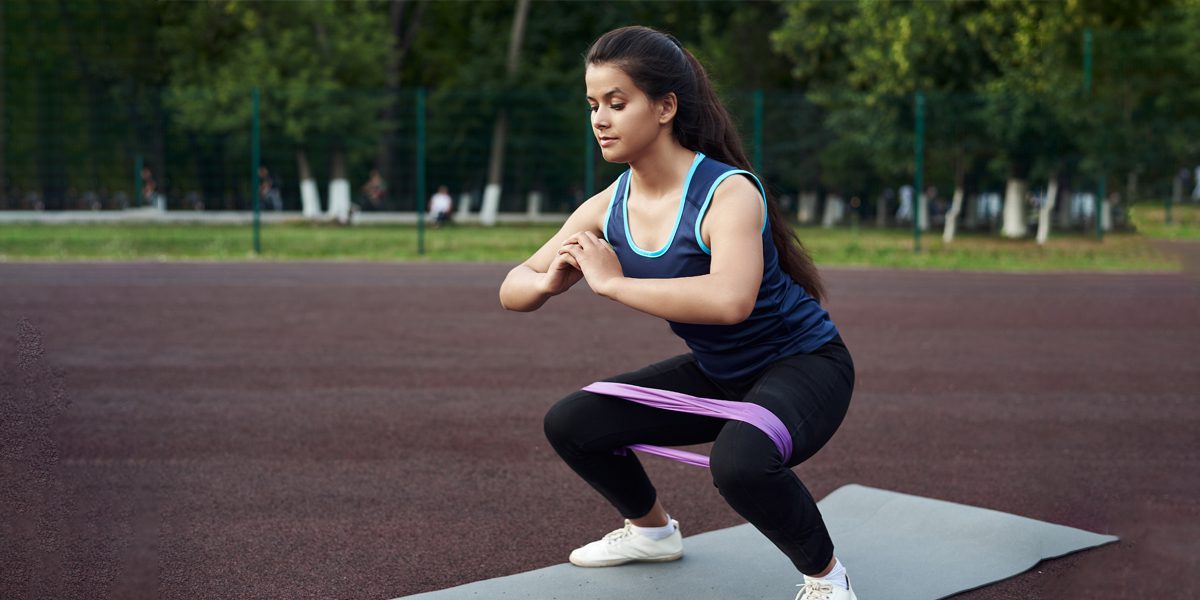Diabetes and Strength Training: How You Can Get Started at Home

Manage Diabetes With Strength Training Exercises
If you’ve been diagnosed with diabetes, you’ve probably heard everyone tell you that exercise is one of the best ways to keep your blood sugar levels in control.
And when one says exercise, most people think of walking, running or some other form of cardiovascular exercise. While we aren’t discrediting the benefits of cardio, there’s more to it.
So let’s break it down for you.
1. Cardiovascular exercises
Also called cardio, this type of exercise works on your heart and lungs by increasing their ability to function better. A common example of it is walking or jogging.
Cardio is especially great for people with diabetes, because it helps increase your blood circulation and manage your blood sugar levels (by burning extra glucose and reducing your body’s resistance to insulin.)
2. Strength training or resistance training
Also called weight training, this form of exercise is important for people with diabetes. Resistance training is a form of exercise that works by using an external resistance such as weights and acts on the major muscle groups of the body like your back, buttocks, arms and chest (depending on the type of resistance training you’re doing) .
Common examples of strength training that you might have come across are weight lifting, working out with resistance bands, heavy gardening and even walking up stairs. And no, these muscle-building exercises are not meant only for bodybuilders!
What you need to know:
Strength training is a MUST in your exercise regimen, because a combination of both these forms of exercises works wonders for people with diabetes. It is known to help in prevention and alleviation for the following health conditions – heart disease, hypertension, obesity, arthritis, and diabetes.
What are some of the benefits of strength training in Diabetes?
1. Helps maintain muscle mass
Strength training exercises are targeted towards your muscles. If muscle strength is not maintained properly, there is an actual loss of muscle mass (sarcopenia). Diabetes has been found to accelerate this process, leading to poor muscle health the longer you have diabetes.
Being physically inactive is a major risk factor for this as well. In today’s day and age, where a sedentary lifestyle is the norm, you need to take early preventive measures to stop this from happening.
2. Improves stamina for day-to-day activities
Every activity that we do requires muscle contraction. Be it brushing your teeth, washing, dressing, cooking, cleaning, work-related activities, shopping etc, nothing is possible without proper muscle health.
Which is why exercises like walking and jogging alone, may help build your cardiorespiratory endurance (the ability of our heart and lungs to carry out any activity for long periods), but done alone may not be beneficial. This has to be combined with training our muscles to do the same effectively.
3. Improves blood sugar levels
When you exercise, your metabolism gets regulated and blood sugar is broken down and utilised by your muscles, in a process known as glucose uptake. When you perform strength training to build your muscles, you increase the glucose uptake by your muscles and help regulate your blood sugar levels.
HbA1c values have also been known to improve with strength training. Short bouts of strength training performed before cardio exercise also reduce the risk of hypoglycemia (sudden drop in blood sugar levels below 70 milligrams per deciliter (mg/dL), or 3.9 millimoles per liter (mmol/L) ), a phenomenon that some people with diabetes experience while exercising.
Reduced HbA1c by HALF in 6 months


6.6%
Happy members
EMI
Guarantee
4.8/5
Diabetes Prime Program
4. Helps you manage your weight
Strength training helps change your fat to muscle ratio, i.e, increase your muscle mass and reduce your fat mass. Obesity and diabetes both are risk factors for dangerous health issues such as heart attack and paralysis.
Therefore, regular exercise can prevent such incidents from happening and ensure a long and healthy life for you.
5. Reduce your risk of suffering from arthritis and osteoporosis
Another factor that affects our quality of life as we get older are joint aches and pains. Diabetes compromises blood vessels, thereby reducing blood supply to your joints.
In addition to that, if your muscles are weak, the load on your bones and joints goes on increasing, eventually, the health of your joints deteriorates and you may end up with arthritis.
Weak bones are brittle (osteoporosis) and will break easily, thus increasing the risk of fractures. With strength training, these disasters can be averted.
But if you thought you’d have to go a gym to strength train, nothing could be farther from the truth — all you really need is the right guidance and some space at home.
Sounds like something you want to try?
4 Tips to start strength training at home
Tip 1: You need some weight, anything will do
You can improvise with the weights available at home, such as water bottles, sandbags, rice bags, and a backpack filled with heavy books/rice/sand etc. Get a little creative and you can find so many items that can be used for weight training!
Tip 2: Use your body weight to your advantage
The best form of resistance comes from your own body weight. In fact, research states that exercises that utilise your body weight (no equipment needed!) and involve multiple joints and muscles simultaneously are preferred over single-joint exercises with weights. This is because:
- Such exercises target larger and major muscle groups simultaneously, leading to a better advantage.
- Bodyweight exercises are more functional, meaning they closely resemble the movements and positions we perform in our daily lives. Hence, if you practice them more, you’ll easily notice the results of this form of training in your day to day life.
So, rest assured, all you need is some free space, a yoga mat and some creative DIY home weights. But most importantly, BYOB (Bring Your Own Body!)
Tip 3: Try these exercises
Bodyweight exercises that can be performed at home:
- Squats
- Lunges
- Triceps dips
- Push-ups
- Planks
- Bridges
Tip 4: The amount matters, so don’t go overboard:
So now we know that exercise is a part of treatment for diabetes. And just like any other medicine, it has its dosage too. ACSM (American College of Sports Medicine) has issued guidelines for exercise dosage for adults.
For the dosage of exercise you should follow what is known as the FITT principle, which is as follows
F: Frequency: How many times should I perform exercises?
An average adult should exercise for at least 150 minutes a week or 30-45 minutes, 4-5 days a week.
I: Intensity: How hard should I work out?
A moderate intensity is ideal (meaning 40-60% of maximal cardio capacity (VO2max). In other words, at a level of effort of 5 or 6 on a scale of 0 to 10 (where 0 is the level of effort of sitting, and 10 is maximal effort) or 50–70% of maximum heart rate.
T: Time: How long should I exercise in a day?
20-60 minutes of cardio exercise, and 3 sets of 8-10 repetitions of 8–10 exercises involving the major muscle groups.
T: Type: What kind of exercises should I perform?
Cardio exercise: A variety of modes of cardio exercise is recommended but any form (including brisk walking, swimming, cycling, Zumba dancing, outdoor sports etc) that uses large muscle groups and causes sustained increases in heart rate is ideal.
Perform cardio exercise spread out at least 3 days during the week, with no more than two consecutive days in between.
Resistance exercise: Undertake resistance exercise at least twice weekly on nonconsecutive days, but more ideally 3 times a week, along with regular cardio exercise. Each session of resistance exercise should involve the major muscle groups (legs, hips, chest, back, abdomen, shoulders, and arms).
Precautions People with diabetes Should Take While Exercising
- Start slow – Start at a comfortable pace, lower weights and lesser repetitions. Remember, Rome was not built in a day!
- Form is important –The technique and posture of every exercise are more important than the need to brag about your number of reps, weight and your gains. Proper form minimises the risk of injury or muscle strains and sprains
- Do not hold your breath while exercising.
- Progress gradually –Initially in terms of repetitions and then in terms of weight is usually preferred.
- Know your capacity – Your exercise heart rate should be within your target heart rate range, which is 50-70% of your maximum heart rate.
- Work through your full range of motion in the absence of any pain complaints.
- Wear comfortable clothing
- Ensure proper grip on weights
- Do not overexert yourself – Keep a gap of one day between two resistance training sessions. Hence we recommend alternate days of cardio and resistance training exercises.
- Take rest – Proper warm-ups and cool-down exercises and stay hydrated. This will ensure safety and minimise the risk of injuries, fatigue, muscle soreness and sudden hypoglycemia (drop in blood sugar level).
- When should People with diabetes not exercise?
Certain circumstances under which exercises are a big no-no are as follows
- Unstable angina
- Uncontrolled hypertension
- Uncontrolled dysrhythmias
- Hypertrophic cardiomyopathy
- Retinopathy
In the presence of certain conditions, you need to be evaluated by an expert before proceeding with exercises
- Congestive heart failure
- Myocardial ischemia
- Poor left ventricular function
- Autonomic neuropathies
FitterTake
Strength training can be a game-changer for people with diabetes. It helps maintain muscles, regulate blood sugar, improve stamina, manage weight, and reduce risks of arthritis and osteoporosis. You can start at home using simple items or bodyweight exercises.
So, if you have diabetes and are unsure about the exercises you can include in your daily lifestyle, explore Fitterfly’s Diabetes Care Program has been curated by expert diabetologists, nutritionists and fitness experts. Wish to know more? Sign up for our program! To speak with us, just give us a missed call at 08068507599, and we will definitely get back to you.
Remember, a healthy lifestyle and mindful food choices are essential for everyone, whether or not they have diabetes.
So, let’s enjoy our exercises wisely and keep our health in check!
This blog provides general information for educational and informational purposes only and shouldn't be seen as professional advice.














